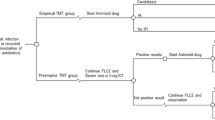Abstract
Several antibiotic regimens have been proposed worldwide for empiric treatment of febrile neutropenia in children with cancer, but none of them shows clear advantages in terms of clinical efficacy. Therefore, other parameters, including drug acquisition costs, should be considered in the selection of treatment. Children receive a "fraction" of a standard daily dose, and this fraction is generally calculated on the basis of body weight; therefore, the cost of each day of therapy is determined by the packages available for each single drug. We calculated the acquisition costs of various drugs proposed for the empiric treatment of febrile neutropenia in children with cancer, and then we estimated the daily cost of therapy referred to different patient weights. In general, the combination regimen with ceftriaxone plus aminoglycoside turned out to be less expensive than other regimens (including monotherapy with third-generation cephalosporins or carbapenems).
Similar content being viewed by others
Author information
Authors and Affiliations
Rights and permissions
About this article
Cite this article
Castagnola, E., Paola, D., Giacchino, R. et al. Economic aspects of empiric antibiotic therapy for febrile neutropenia in children with cancer. Support Care Cancer 6, 524–528 (1998). https://doi.org/10.1007/s005200050208
Issue Date:
DOI: https://doi.org/10.1007/s005200050208




